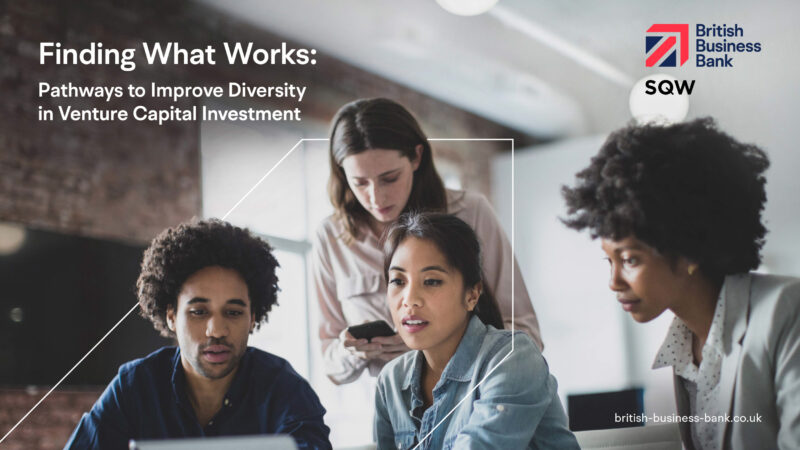
Venture capital
Venture capital is a form of investment in early-stage companies with strong growth potential. The types of businesses venture capital firms invest in tend to be young and often pre-profit, and potentially even pre-revenue. Venture capital funds buy minority equity stakes in these companies and provide them with financial support and business expertise to help them grow and succeed.
Limited Partners
Investors of venture capital firms are called Limited Partners (LPs). LPs are the institutional or individual investors that have invested or committed capital in the funds of the venture capital firm. LPs include endowments, corporate pension funds, sovereign wealth funds, wealthy families, and funds of funds.
Venture capital-ready entrepreneur
- Private, independent UK company
- Received between £50k - £1m in total equity investment
- Has not been involved in any announced equity investment deals involving venture capital or private equity investors.
Venture capital-backed entrepreneur
- Private, independent UK company
- Has been involved in any announced equity investment deals involving venture capital or private equity investors.
Seed stage
Seed stage encompasses young companies with a small team, low valuation and have received relatively low levels of funding relative to the sector. They have uncertain product market fit or just getting started with the process of getting regulatory approval. Funding is likely to come from grant-awarding bodies, equity crowdfunding and business angels but may include early-stage venture capital firms.
Venture stage
Venture stage covers companies that have been in existence for a few years and are in the process of gaining market traction with sales growing rapidly. The venture stage does not solely correspond to funding by venture capital firms, as other investor types also provide funding to venture stage companies.
Growth stage
Growth stage businesses are more developed with multiple offices or branches and substantial revenue streams (some of which may be profitable). The growth stage includes later stage venture capital-backed companies seeking to grow their core market, expand into new markets or create new products/services.
Incubators
Incubators are typically physical spaces, available on relatively flexible terms, which provide additional incubation services (Dee et al., 2015). These services generally include provision of training for entrepreneurs, access to networks and specialist equipment. Incubators are typically dependent on charging rent or membership fees to residents, often on a monthly basis (Dee et al., 2015; Aerts et al., 2007). In many cases, incubators are aligned with a university, supporting spin-outs along with other local businesses.
Business Accelerators
Accelerators typically provide services through a highly selective, cohort-based programme of limited duration (usually 3-12 months). Services often include assistance in developing the business plan, investor pitch deck, prototypes, and initial market testing. Accelerators more often base their business model on equity from the start-ups. This means that they are more growth driven, typically aiming to produce companies that will scale rapidly or fail fast, thus minimising wasted resources. Increasingly, accelerators are providing support designed for more established and high growth companies looking to scale up their business.
Office hours
Open Office Hours are periods of time that a venture capital firm provides to meet with founders, answer questions, hear ideas and give advice and guidance.
Scouts
Scouts are connectors that may assist venture capital firms in discovering hidden and/or exceptional start-ups and founders to invest in.
Diversity
The practice or quality of including or involving people from a range of different backgrounds.
Inclusion
The practice of providing equal access to opportunities and resources for people who might otherwise be excluded or marginalised.
Correlation
A correlation is a relationship or connection between two variables. A positive correlation implies that variables tend to ‘move’ in the same direction – when one has a larger values the other one also is likely to have a larger value. A negative correlation implies the tendency to move in the opposite directions (when one variable is smaller the other one tends to have a larger value).
Causality
A relationship between cause and effect i.e. a situation where there is conclusive evidence on the sequence (e.g. one variable increases first and that leads to a change in the other one).
Factor
Factors are unobserved variables that affect the values of groups of observed, usually correlated, variables and which can be identified by the means of statistical analysis.
The mean
A measure that identifies the centre of a distribution of values, a way to describe the average. The arithmetic mean is the most common type of this measure (the sum of all observations divided by the number of observations).
The median
An alternative measure of the centre of a distribution. 50% of observations have a lower value than the median and 50% have higher values. The median is less sensitive to outliers than the arithmetic mean
Normal and quasi-normal distribution
A distributions of values of a variable that is symmetric around the mean and the values around the mean are more common than those far away from it (i.e. the distribution has a bell shape).
Statistical significance
A result is statistically significant if it is unlikely to be caused by chance. The level of statistical significance is the probability of being wrong when concluding that the effect/ relationship is present.
Statistical test
A mechanism that allows to make quantitative decisions about a hypothesis.